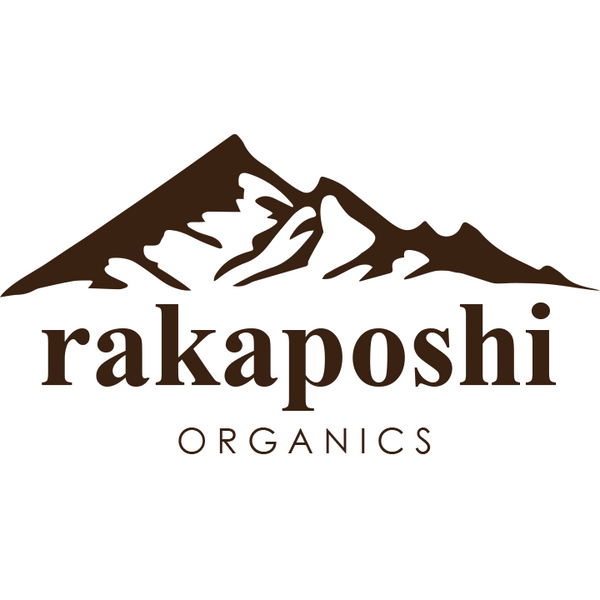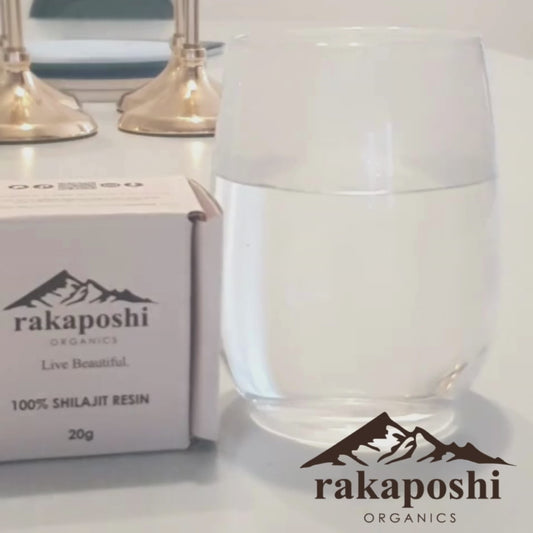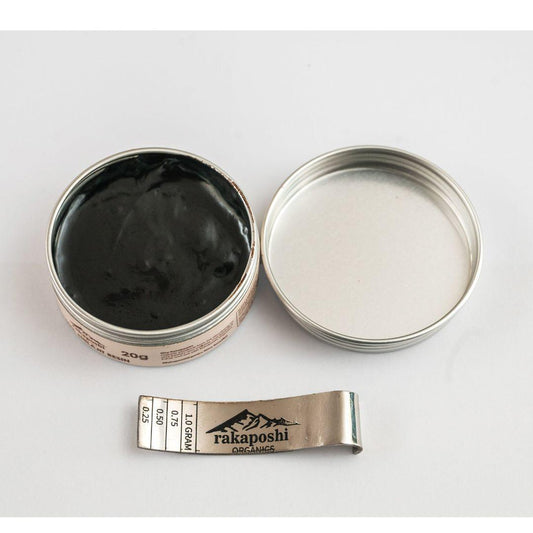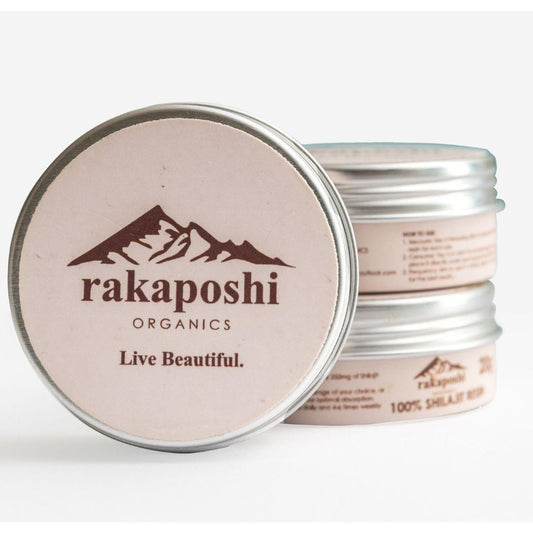
Customer Q&A: Does Mixing with Hot Water Damage Shilajit?
Share
Introduction: A Common Question
Last week, I received a question from one of our customers, one that can easily be a source of confusion due to the lack of credible, scientific information available about shilajit. While things are improving, gaps in our understanding of this ancient mineral supplement still exist.
The issue raised was whether mixing shilajit in hot water would damage it, referring directly to our website, where we recommend mixing our shilajit into hot water and consuming it like a tonic every morning.
See: [How to Use and What to Expect]
The customer shared an image suggesting that temperatures above 60°C would damage shilajit and sought clarification.
The Importance of Critical Evaluation
Throughout my journey with shilajit, I've encountered many misrepresentations, sensational claims, and ambiguous statements, often with little to no supporting evidence. Therefore, I believe that any claim (especially from a shilajit vendor) should be subjected to rigorous examination before accepting it as true.
It's crucial for each of us to:
- Educate ourselves about product composition
- Validate "facts" before accepting them
- Ask for evidence supporting claims
- Avoid being misled by exaggerated or unsupported statements
Let's break down this question and examine the science:
What Is Shilajit Made Of?
A purified, high-quality shilajit (regardless of its origin) primarily consists of:
- Humic acid (typically 15-40% by weight)
- Fulvic acid (typically 40-60% by weight in quality sources)
- Trace minerals (iron, magnesium, zinc, calcium, and 80+ others)
- Other organic compounds (dibenzo-alpha-pyrones, etc.)
These are the primary components of authentic shilajit resin.
Thermal Stability of Shilajit Components
Minerals: Highly Stable
The science:
- Minerals (iron, magnesium, zinc, etc.) are inorganic compounds
- They are stable at very high temperatures
- Similar to minerals in food (vegetables, grains, etc.)
Comparison:
- Cooking vegetables doesn't degrade their mineral content
- Minerals remain stable even at cooking temperatures (100-200°C)
- The same principle applies to minerals in shilajit
Conclusion: The mineral content of shilajit is not affected by hot water (100°C / 212°F).
Fulvic Acid: Stable at Boiling Temperatures
What research shows:
Fulvic acid is known for its stability under various conditions. Thermal analysis studies indicate that fulvic acid does not begin to degrade until exposed to very high temperatures.
Key findings:
- Significant decomposition typically occurs above 300°C (572°F)
- Even when bound to minerals (metal-fulvic acid complexes), decomposition begins at temperatures far exceeding boiling water
- Thermal stability studies show fulvic acid remains structurally intact at temperatures well above 100°C
Reference: "Differential thermal analysis of metal-fulvic acid salts and complexes" demonstrates that fulvic acid complexes are stable at temperatures far above boiling water.
Humic Acid: Similarly Stable
What research shows:
Humic acid is similarly stable at high temperatures. Like fulvic acid, it begins to decompose at temperatures well above boiling water.
Key findings:
- Decomposition typically begins around 200-350°C
- Structural changes occur at much higher temperatures than boiling water
- Thermal stability studies confirm humic acid remains intact at 100°C
References:
- "Thermal stability of solid and aqueous solutions of humic acid"
- "Effects of heating on composition, degree of darkness, and stacking nanostructure of soil humic acids"
Both studies demonstrate that humic acid is stable at temperatures encountered during normal preparation.
The Bottom Line: Temperature Comparison
To put it simply:
Water boils at: 100°C (212°F)
Fulvic acid begins decomposing at: >300°C (572°F)
Humic acid begins decomposing at: 200-350°C (392-662°F)
Minerals are stable at: Much higher temperatures than boiling water
Conclusion: Hot water (even boiling water) will not degrade the chemical composition of shilajit. The temperature is far below the decomposition points of its primary components.
Addressing the 60°C Claim
The claim: Some sources suggest shilajit is damaged at temperatures above 60°C (140°F).
The science: This claim is not supported by thermal stability research on fulvic acid, humic acid, or minerals.
Possible origins of this claim:
- Misunderstanding of research
- Confusion with other substances
- Marketing differentiation (claiming superiority)
- Lack of scientific basis
What to do if you encounter this claim:
- Ask the producer for clarification
- Request scientific evidence supporting the claim
- Ask for chemical analysis reports showing composition
- Compare with published thermal stability research
Composition and Traditional Use
Important context:
While we're discussing the chemical stability of shilajit's components, it's important to note:
- Shilajit has been used in traditional medicine for centuries
- Traditional preparation methods often involve dissolving in warm or hot water
- The composition (fulvic acid, humic acid, minerals) remains intact when prepared this way
- Chemical stability doesn't equal proven health benefits (research on health effects is very limited, as covered in previous blogs)
We're addressing composition and preparation, not making health claims.
How to Verify Quality Claims
When evaluating shilajit products or claims:
1. Ask for chemical analysis:
- Fulvic acid content
- Humic acid content
- Mineral composition
- Heavy metal testing
- Microbial testing
2. Request batch-specific reports:
- Each batch should be tested
- Results should be available to customers
- Look for third-party lab testing
3. Evaluate claims critically:
- Are they supported by research?
- Are citations provided?
- Can you verify the sources?
- Do they make sense scientifically?
4. Look for transparency:
- Specific sourcing information
- Processing methods disclosed
- Honest about what is and isn't known
- Realistic rather than exaggerated claims
Our Approach at Rakaposhi Organics
Transparency and quality:
- Every batch is tested individually
- Chemical analysis reports available
- Third-party lab verification
- Heavy metal screening
- Honest about composition and preparation
Traditional preparation:
- Dissolving in warm or hot water is traditional
- This method doesn't damage the chemical composition
- Supported by thermal stability research
- Consistent with centuries of traditional use
Realistic information:
- We focus on what we can verify (composition, purity, sourcing)
- We cite research when making factual claims
- We're honest about limitations in research
- We encourage customers to ask questions and verify information
Practical Preparation Guidelines
How to prepare shilajit:
Traditional method:
- Dissolve pea-sized portion (300-500mg) in warm or hot water
- Stir until fully dissolved
- Consume as desired
Temperature considerations:
- Warm to hot water is fine (based on thermal stability research)
- Boiling water is also fine (though not necessary)
- Room temperature water works but takes longer to dissolve
- Traditional use involves warm water
Timing:
- Often consumed in morning (traditional pattern)
- Can be taken at other times based on preference
- Consistency matters more than specific timing
Frequently Asked Questions
Does hot water destroy shilajit's composition?
No. Research on the thermal stability of fulvic acid, humic acid, and minerals shows that these components are stable at temperatures well above boiling water (100°C). Decomposition occurs at much higher temperatures (200-350°C+). Hot water does not damage shilajit's chemical composition.
Where does the 60°C claim come from?
This claim is not supported by scientific research on fulvic acid, humic acid, or mineral stability. It may stem from misunderstanding, confusion with other substances, or marketing claims. If you encounter this claim, ask for scientific evidence supporting it.
How can I verify the quality of shilajit?
Ask for batch-specific chemical analysis reports showing fulvic acid content, humic acid content, mineral composition, heavy metal testing, and microbial testing. Look for third-party lab verification. Evaluate whether claims are supported by research and citations.
What temperature should I use to prepare shilajit?
Warm to hot water is traditional and works well for dissolving shilajit. Based on thermal stability research, even boiling water is fine (though not necessary). Room temperature water also works but takes longer to dissolve. Use whatever temperature you prefer.
Does preparation method affect composition?
The chemical composition (fulvic acid, humic acid, minerals) remains stable when dissolved in hot water based on thermal stability research. Traditional preparation methods (warm/hot water) don't damage these components.
The Bottom Line
Key takeaways:
Scientific evidence:
- Fulvic acid is stable above 300°C
- Humic acid is stable at 200-350°C
- Minerals are stable at high temperatures
- Boiling water (100°C) is far below decomposition temperatures
Practical application:
- Hot water does not damage shilajit's composition
- Traditional preparation (warm/hot water) is supported by science
- Claims about damage at 60°C are not scientifically supported
Quality verification:
- Ask for chemical analysis reports
- Look for batch-specific testing
- Evaluate claims critically
- Choose transparent suppliers
Realistic perspective:
- We're discussing composition and preparation
- Chemical stability doesn't equal proven health benefits
- Research on health effects is very limited
- Focus on verified facts (composition, purity, sourcing)
In short, high-quality shilajit can be safely mixed with hot water without affecting its chemical composition. The claim that shilajit will be damaged at temperatures above 60°C is not supported by scientific research on thermal stability.
If you encounter such claims, ask the producer for clarification and chemical analysis reports to verify their product's composition and purity.
Citations:
-
Thermal stability of solid and aqueous solutions of humic acid. Thermochimica Acta, 1984.
-
Differential thermal analysis of metal-fulvic acid salts and complexes. Soil Science, 1971.
-
Effects of heating on composition, degree of darkness, and stacking nanostructure of soil humic acids. Journal of Molecular Structure, 2013.
Discover authentic Rakaposhi Gold Shilajit—sourced from the Karakoram mountains of Gilgit-Baltistan at elevations of 15,000-20,000+ feet, processed using traditional Aftabi sun-drying methods, with batch-specific testing for purity and safety. Every batch is independently lab-tested for fulvic acid content, heavy metals, and microbial contamination. We provide transparent information about composition, sourcing, and preparation based on scientific research and traditional use.



